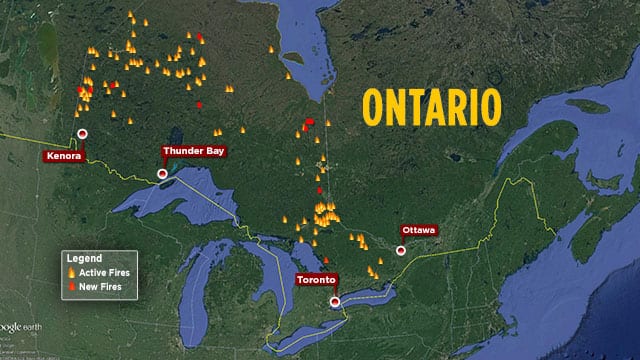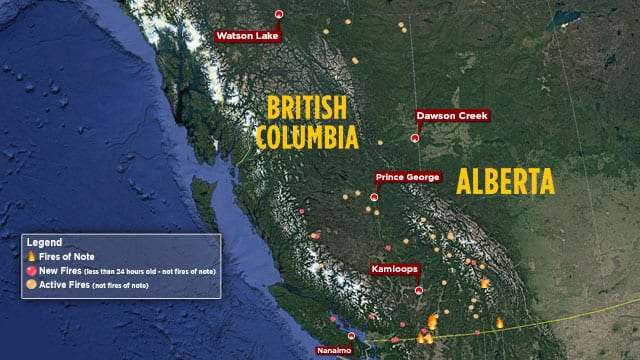
It was about 5 p.m. Saturday when Angèle Dubois received the text from her mom: Their community of Henvey Inlet First Nation was being evacuated due to the looming wildfires in Parry Sound, Ont.
Dubois, who lives on the Pickerel River, collected her dog and cat, packed a bag of clothes and a few treasured items including photos and a pair of mukluks.
“The windows were open and it was really smoky. Even while going in and out of the house, it was getting more and more smoky,” said Dubois from a hotel in Parry Sound where she’s temporarily staying (her dad, who lives north of Sudbury, is currently looking after her pets).
“I realized more how smoky it was when I got to the hotel and took a shower and I could smell my clothes.”
Dubois is among 175 Henvey Inlet Indian Band members who was evacuated from the community on Saturday.
They’re now staying in hotels or with family members in Parry Sound or Sudbury, as the “Parry Sound 33” fire has ripped through almost 5,000 hectares of land.
The cause of the fire is still under investigation.
In a press release, Chief Wayne McQuabbie said the community is not in “imminent” danger, but the band decided to evacuate to “ensure the safety of the community.”
Meanwhile, McQuabbie has been monitoring the community’s buildings and animals family members had to leave behind.
Kyla McQuabbie, the chief’s niece, left her home with her three children – aged four, seven and eight – in tow.
“I just got my kids to throw all their clothes in bags and got out,” she said.
“I was just kind of panicked at first. I just tried to remain calm for my kids’ sake because they were very panicked and stressed out.”
Currently, the Ministry of Natural Resources and Forestry is reporting 133 active wildfires across Ontario, with 60 in the northeastern region.
The province’s largest forest blaze, measuring more than 27,000 hectares, is burning through Lady Evelyn Smoothwater Provincial Park.
This year, the ministry has recorded 803 wildfires across Ontario. That’s almost double the 10-year average of 475 wildfires.
This time last year, the province reported just 190 fires.
Crews from nearly every province, plus the Northwest Territories, Wisconsin, Minnesota and Mexico, have been called in to help battle the surplus of fires.
On the northwestern side of the province, about 70 or 80 of Wabaseemoong First Nation’s most vulnerable members were evacuated last week, including children, elders and those with respiratory illnesses.
Meanwhile, almost 900 properties are under an evacuation alert in British Columbia, meaning those property owners are ordered ready to leave if the wildfires get too close.

There is concern climbing temperatures and gusty winds could undo progress made over the last several days.
Environment Canada is calling for winds gusting to 40 kilometres per hour over the Kelowna area and lightning is also forecast for several parts of the province, including the Okanagan Valley.
The Wildfire Service says it conducted a successful controlled burn on Sunday, uniting two fires into one larger blaze between Peachland and Summerland, on the west side of Okanagan Lake.
That fire now covers just over 15-square kilometres.
While the blaze is still considered out of control, officials say the single perimeter offers a greater chance to build fire guards.
Penticton Indian Band, almost 60 kilometres south of Kelowna, also issued an evacuation alert this weekend.
Dale Kronebusch, the band’s emergency services coordinator, blames the fires on a mix of dry weather, heat and lightning storms with little or no precipitation.
“It is tinderbox dry right now,” he said. “We’ve seen a little bit of rain, but not nearly enough.”
– With files from The Canadian Press










